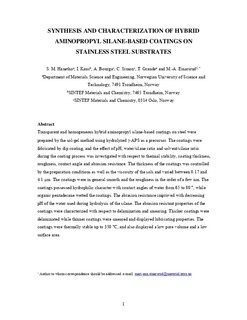| dc.contributor.author | Hanetho, Sidsel Meli | |
| dc.contributor.author | Kaus, Ingeborg | |
| dc.contributor.author | Simon, Christian | |
| dc.contributor.author | Bouzga, Aud Mjærum | |
| dc.contributor.author | Grande, Tor | |
| dc.contributor.author | Einarsrud, Mari-Ann | |
| dc.date.accessioned | 2019-08-08T10:08:49Z | |
| dc.date.available | 2019-08-08T10:08:49Z | |
| dc.date.created | 2014-01-27T08:16:27Z | |
| dc.date.issued | 2014 | |
| dc.identifier.citation | Surface & Coatings Technology. 2014, 238 1-8. | nb_NO |
| dc.identifier.issn | 0257-8972 | |
| dc.identifier.uri | http://hdl.handle.net/11250/2607564 | |
| dc.description.abstract | Transparent and homogeneous hybrid aminopropyl silane-based coatings on steel were prepared by the sol–gel method using hydrolyzed γ-APS as a precursor. The coatings were fabricated by dip coating, and the effect of pH, water/silane ratio and solvent/silane ratio during the coating process was investigated with respect to thermal stability, coating thickness, roughness, contact angle and abrasion resistance. The thickness of the coatings was controlled by the preparation conditions as well as the viscosity of the sols and varied between 0.17 and 4.1 μm. The coatings were in general smooth and the roughness was in the order of a few nanometer. The coatings possessed hydrophilic character with contact angles of water from 65 to 80°, while organic pentadecane wetted the coatings. The abrasion resistance improved with decreasing pH of the water used during hydrolysis of the silane. The abrasion resistant properties of the coatings were characterized with respect to delamination and smearing. Thicker coatings were delaminated while thinner coatings were smeared and displayed lubricating properties. The coatings were thermally stable up to 350 °C, and also displayed a low pore volume and a low surface area. | nb_NO |
| dc.language.iso | eng | nb_NO |
| dc.publisher | Elsevier | nb_NO |
| dc.rights | Attribution-NonCommercial-NoDerivatives 4.0 Internasjonal | * |
| dc.rights.uri | http://creativecommons.org/licenses/by-nc-nd/4.0/deed.no | * |
| dc.title | Synthesis and characterization of hybrid aminopropyl silane-based coatings on stainless steel substrates | nb_NO |
| dc.type | Journal article | nb_NO |
| dc.type | Peer reviewed | nb_NO |
| dc.description.version | acceptedVersion | nb_NO |
| dc.source.pagenumber | 1-8 | nb_NO |
| dc.source.volume | 238 | nb_NO |
| dc.source.journal | Surface & Coatings Technology | nb_NO |
| dc.identifier.doi | 10.1016/j.surfcoat.2013.10.013 | |
| dc.identifier.cristin | 1100033 | |
| dc.relation.project | Norges forskningsråd: 180038 | nb_NO |
| cristin.unitcode | 7401,80,3,1 | |
| cristin.unitcode | 7401,80,6,7 | |
| cristin.unitcode | 7401,80,3,3 | |
| cristin.unitname | Nye energiløsninger | |
| cristin.unitname | Nano-og hybridmaterialer | |
| cristin.unitname | Sorbentbaserte teknologier | |
| cristin.ispublished | true | |
| cristin.fulltext | postprint | |
| cristin.qualitycode | 1 | |

